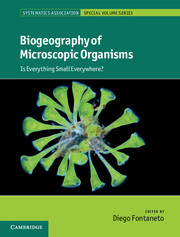Book contents
- Frontmatter
- Contents
- List of contributors
- Preface
- Part I Theoretical framework
- Part II Prokaryotes
- Part III Unicellular eukaryotes
- Part IV Pluricellular eukaryotes
- Part V Processes
- 15 Microbes as a test of biogeographic principles
- 16 A metacommunity perspective on the phylo- and biogeography of small organisms
- 17 Geographic variation in the diversity of microbial communities: research directions and prospects for experimental biogeography
- Index
- Systematics Association Publications
- Systematics Association Special Volumes
- Plate section
- References
16 - A metacommunity perspective on the phylo- and biogeography of small organisms
from Part V - Processes
Published online by Cambridge University Press: 05 August 2012
- Frontmatter
- Contents
- List of contributors
- Preface
- Part I Theoretical framework
- Part II Prokaryotes
- Part III Unicellular eukaryotes
- Part IV Pluricellular eukaryotes
- Part V Processes
- 15 Microbes as a test of biogeographic principles
- 16 A metacommunity perspective on the phylo- and biogeography of small organisms
- 17 Geographic variation in the diversity of microbial communities: research directions and prospects for experimental biogeography
- Index
- Systematics Association Publications
- Systematics Association Special Volumes
- Plate section
- References
Summary
Dispersal in small organisms
Small organisms rely on passive dispersal for colonising new habitats. Especially when they form resistant stages, passive dispersal does not translate into weak or limited dispersal (Bilton et al., 2001; Havel and Shurin, 2004). The main cost of passive dispersal is that the organism has no control over the trajectory and destination. By having adaptations for specific vectors (e.g. animals instead of wind), directionality and destination can to a certain extent be influenced. In aquatic organisms and plants, there is increasing evidence of widespread and potentially long-distance dispersal by a multitude of vectors, ranging from wind (Vanschoenwinkel et al., 2008a) and birds (Green et al., 2002; Figuerola et al., 2005) to insects (Van de Meutter et al., 2008), mammals (Vanschoenwinkel et al., 2008b) and humans and their transportation means (Havel et al., 2002). This translates into relatively high dispersal rates, as is shown by rapid colonisation rates of new habitats and rapid spread of exotic species (e.g. Louette and De Meester, 2005; Havel and Shurin, 2004). Specific characteristics may make some species better dispersers than others, and dispersal rates in practice will also largely depend on abundance (i.e. sources of individuals). Effective dispersal, i.e. dispersal followed by establishment success, will in addition depend on the occurrence of habitats and their suitability for the focal species, and thus also on ecological specialisation and habitat preference of these species.
- Type
- Chapter
- Information
- Biogeography of Microscopic OrganismsIs Everything Small Everywhere?, pp. 324 - 334Publisher: Cambridge University PressPrint publication year: 2011
References
- 10
- Cited by

